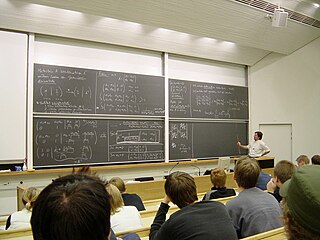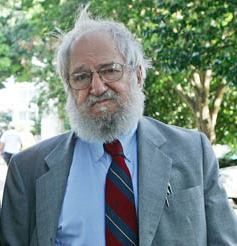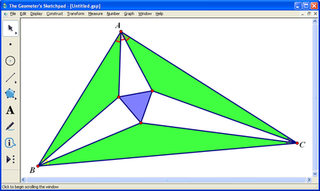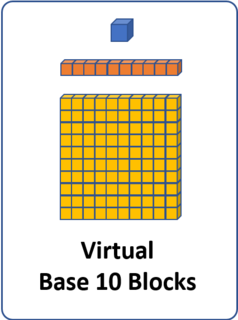
Mathematics is an area of knowledge, which includes the study of such topics as numbers, formulas and related structures (algebra), shapes and spaces in which they are contained (geometry), and quantities and their changes. There is no general consensus about its exact scope or epistemological status.

In contemporary education, mathematics education is the practice of teaching and learning mathematics, along with the associated scholarly research.
A cognitive tutor is a particular kind of intelligent tutoring system that utilizes a cognitive model to provide feedback to students as they are working through problems. This feedback will immediately inform students of the correctness, or incorrectness, of their actions in the tutor interface; however, cognitive tutors also have the ability to provide context-sensitive hints and instruction to guide students towards reasonable next steps.

The Centre for Education in Mathematics and Computing (CEMC) is Canada's largest and most recognized outreach organization for promoting and creating activities and materials in mathematics and computer science housed within the Faculty of Mathematics at the University of Waterloo. It was founded in 1995 with origins dating back to the 1960s. Its mission is to increase interest, enjoyment, confidence, and ability in mathematics and computer science among learners and educators in Canada and internationally.
Principles and Standards for School Mathematics (PSSM) are guidelines produced by the National Council of Teachers of Mathematics (NCTM) in 2000, setting forth recommendations for mathematics educators. They form a national vision for preschool through twelfth grade mathematics education in the US and Canada. It is the primary model for standards-based mathematics.
Founded in 1920, The National Council of Teachers of Mathematics (NCTM) is the world's largest mathematics education organization.

Constructionist learning is the creation by learners of mental models to understand the world around them. Constructionism advocates student-centered, discovery learning where students use what they already know, to acquire more knowledge. Students learn through participation in project-based learning where they make connections between different ideas and areas of knowledge facilitated by the teacher through coaching rather than using lectures or step-by-step guidance. Further, constructionism holds that learning can happen most effectively when people are active in making tangible objects in the real world. In this sense, constructionism is connected with experiential learning and builds on Jean Piaget's epistemological theory of constructivism.

GeoGebra is an interactive geometry, algebra, statistics and calculus application, intended for learning and teaching mathematics and science from primary school to university level. GeoGebra is available on multiple platforms, with apps for desktops, tablets and web.

The Geometer's Sketchpad is a commercial interactive geometry software program for exploring Euclidean geometry, algebra, calculus, and other areas of mathematics. It was created as part of the NSF-funded Visual Geometry Project led by Eugene Klotz and Doris Schattschneider from 1986 to 1991 at Swarthmore College. Nicholas Jackiw, a student at the time, was the original designer and programmer of the software, and inventor of its trademarked "Dynamic Geometry" approach; he later moved to Key Curriculum Press, KCP Technologies, and McGraw-Hill Education to continue ongoing design and implementation of the software over multiple major releases and hardware platforms. Present versions run Microsoft Windows and Mac OS 8. It also runs on Linux under Wine with a few bugs. There was also a version developed for the TI-89 and TI-92 series of Calculators. In June 2019 McGraw-Hill announced they will no longer sell new licenses. Nonetheless, a new (2021) 64-bit version of Mac Sketchpad that is compatible with the new Apple M1 silicon chips is available as part of an ongoing beta test. No license for the beta software is required. Additionally, all 12 Sketchpad activity modules, ranging from grade 3 mathematics through calculus, are available for complimentary download.
An intelligent tutoring system (ITS) is a computer system that aims to provide immediate and customized instruction or feedback to learners, usually without requiring intervention from a human teacher. ITSs have the common goal of enabling learning in a meaningful and effective manner by using a variety of computing technologies. There are many examples of ITSs being used in both formal education and professional settings in which they have demonstrated their capabilities and limitations. There is a close relationship between intelligent tutoring, cognitive learning theories and design; and there is ongoing research to improve the effectiveness of ITS. An ITS typically aims to replicate the demonstrated benefits of one-to-one, personalized tutoring, in contexts where students would otherwise have access to one-to-many instruction from a single teacher, or no teacher at all. ITSs are often designed with the goal of providing access to high quality education to each and every student.
Traditional mathematics was the predominant method of mathematics education in the United States in the early-to-mid 20th century. This contrasts with non-traditional approaches to math education. Traditional mathematics education has been challenged by several reform movements over the last several decades, notably new math, a now largely abandoned and discredited set of alternative methods, and most recently reform or standards-based mathematics based on NCTM standards, which is federally supported and has been widely adopted, but subject to ongoing criticism.
MicroWorlds JR is a computer program using a simplified version of the Logo programming language to teach non-readers or early readers to program in Logo. It was first launched in 2004 by Logo Computer Systems, Inc. (LCSI), and as in their original line of MicroWorlds programs, the object on the screen begins as a turtle and can be controlled with basic commands to make it move. Differing from the Logo syntax developed by Seymour Papert and teams at MIT, MicroWorlds JR uses images to replace the command names, which are selected by the child to create turtle graphics. The turtle object can be given a variety of shapes that act as a costume for the turtle, and therefore lends itself to a variety of animations and creative stories and projects for younger students.
Mathematical anxiety, also known as math phobia, is anxiety about one's ability to do mathematics.

Virtual math manipulatives are visual representations of concrete math manipulatives that are digitally accessed through a variety of websites or apps on digital devices including tablets, phones and computers. Virtual math manipulatives are modeled after concrete math manipulatives that are commonly used in classrooms to concretely represent abstract mathematical concepts and support student understanding of mathematical content.

The Arkansas Department of Education (ADE) is a cabinet-level agency of the Arkansas state government overseeing public education for K-12, higher education institutions, and career and technical education.
From kindergarten through high school, the mathematics education in public schools in the United States has historically varied widely from state to state, and often even varies considerably within individual states. With the recent adoption of the Common Core Standards by 45 states, mathematics content across the country is moving into closer agreement for each grade level.
In mathematics education, a representation is a way of encoding an idea or a relationship, and can be both internal and external. Thus multiple representations are ways to symbolize, to describe and to refer to the same mathematical entity. They are used to understand, to develop, and to communicate different mathematical features of the same object or operation, as well as connections between different properties. Multiple representations include graphs and diagrams, tables and grids, formulas, symbols, words, gestures, software code, videos, concrete models, physical and virtual manipulatives, pictures, and sounds. Representations are thinking tools for doing mathematics.

Math Blaster! is a 1983 edutainment video game, and the first entry in the "Math Blaster" series within the Blaster Learning System created by Davidson & Associates. The game was developed by former educator Jan Davidson. It would be revised and ported to newer hardware and operating systems, with enhanced versions rebranded as Math Blaster Plus! (1987) followed by New Math Blaster Plus! (1990). A full redesign was done in 1993 as Math Blaster Episode I: In Search of Spot and again in 1996 as Mega Math Blaster.

Gary Bitter is an American researcher, teacher, author and pioneer in educational technology. He is Professor of Educational Technology and past Executive Director of Technology Based Learning and Research at Arizona State University. He was a founding board member of the International Society for Technology in Education and served as its first elected president. He is the co-author of the National Technology Standards (NETS) which have been used extensively as a model for National and International Technology Standards.
Mind Power series is a collection of educational video games for the Windows and Macintosh platforms, developed and published by The Learning Company. This consists of the packages Mind Power Math: Middle School, Mind Power Math: High School and Mind Power Science Grades 7-12 Each package contains CD focuses on a certain topic. The products were designed to allow growing students to interact with the study material.










